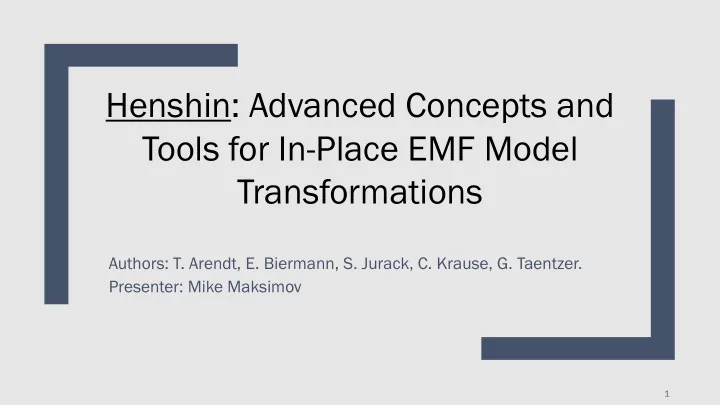

Henshin: Advanced Concepts and Tools for In-Place EMF Model Transformations Authors: T. Arendt, E. Biermann, S. Jurack, C. Krause, G. Taentzer. Presenter: Mike Maksimov 1
Introduction to MDD Model Driven Development (MDD) Promising paradigm in software engineering • • Ideal means of abstraction • Manages complexity of software systems Model Transformation • Essential activity in MDD • Transformation types • In-place, Out-Place. • Endogenous, Exogenous. 2
Introduction to EMF Eclipse Modelling Framework (EMF) • Modeling and code generation capabilities • Describes structural aspects of models only Existing in-place transformation languages They are too simple • Not declarative enough • Do not support formal reasoning • Example languages • • Kermeta, EMF Tiger, EWL, Moment2. 3
Henshin Overview Henshin - Transformation Language: • Powerful language offering formal reasoning Operates directly on EMF models • • In-place endogenous and exogenous support • Based on graph transformations Henshin - Characteristics: Rules • • Application Conditions • Transformation Units 4
Henshin Transformation Meta-model 5
Transformation Rules • Rules consist of LHS and RHS graphs The LHS matches to the source graph • • RHS replaces the matched source graph 6
Attributes and Conditions • Henshin supports the addition of attributes • Attribute conditions can be added on rules 7
Application Conditions • Determine where a rule should be applied • Set graph conditions using first order logical formulas • Positive Application Conditions (PACs) - Require the presence of elements or relationships • Negative Application Conditions (NACs) - Forbid the presence of elements or relationships Can be nested • 8
Transformation Units Control flow is specified using • units Support object and parameter • passing • Types - Sequential Units - Priority Units - Independent Units - Loop Units - Conditional Units - Amalgamation Units 9
Transformation Rules & Units: Example 10
Henshin In Meta-Model Evolution • In MDD models are the key artifacts and they evolve over time • Henshin supports transformation rules for both meta-models and instances • Example of an evolving Petri Net meta-model on the right 11
Henshin In Meta-Model Evolution 12
Henshin In Meta-Model Evolution 13
Henshin In Meta-Model Refactoring Model Refactoring Demonstration: • Pull ll U Up Att ttrib ibute example - Moves a common attribute from all subclasses to the superclass • Pull ll U Up Att ttrib ibute preconditions 14
Henshin In Meta-Model Refactoring 15
Henshin Tool Environment Henshin Editors: • Tree Based Editor (Generated by EMF) • GMF Graphical Editor Tool Characteristics: • Integrated view between LHS & RHS Built in state space generator • Support for model checking • Integrated OCL validator • 16
Discussion – Pros & Cons 1. Do you think that Henshin is limited in the fact that it only supports EMF models? 2. Do you prefer the split LFH and RHS interface or the joint variation? 3. Was the paper well written in your opinion? 4. Enough support for exogenous transformations? 17
Recommend
More recommend